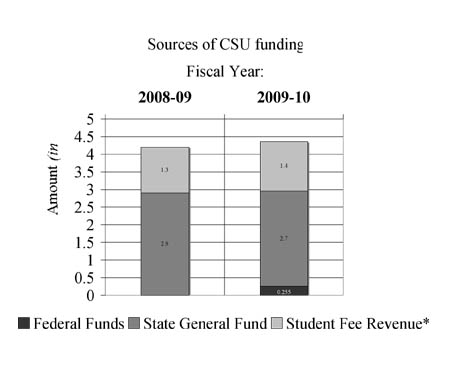The 17-month California state budget was signed on Feb. 20 by Gov. Arnold Schwarzenegger, but its implications for Cal State Long Beach students still remain largely unclear.
According to CSULB President F. King Alexander, many of the belt-tightening measures CSULB has already set in place are likely to continue under the new budget. These measures include reducing the number of available course options, making fewer employment opportunities available to students, and trimming the number of faculty and staff.
The state budget holds a $97 million cut to the current California State University system budget and assumes that there will be a 10 percent increase in student fees for 2009-10.
Nonetheless, it will maintain level funding between the 2008-09 and 2009-10 fiscal years, preserve financial aid and pave the way for campuses to resume halted construction projects — at least for now.
A number of factors could negatively affect CSU funding between now and the beginning of the 2009-10 fiscal year.
Possible bumps in the budgetary road
There’s a fair risk that things could change between now and September,” said CSULB Vice Provost David Dowell.
First, implementation of many of the budget’s new tax provisions — such as the 1 percent sales tax increase and doubling of vehicle registration fees — is dependent on voter approval in May. If these measures are not passed, revenue projections would have to be re-evaluated.
Second, the budget is made based on projections of tax revenue but, historically, those projections have not always been met by actual tax revenue totals.
“There is plenty of reason to think that tax revenues may fall short [for the upcoming year],” Dowell said.
Finally, there is a series of “trigger cuts” written into the budget that could go into effect if the state fails to receive at least $10 billion of the federal funds set aside for state aid in the recently-passed stimulus package, the American Economic Recovery and Reinvestment Act of 2009.
If the state receives less than $10 billion of these federal funds, it could cut the CSU budget by $50 million.
According to current projections by the state’s Department of Finance, California’s share is likely to fall short of the $10 billion threshold by $2.1 billion. The final decision on whether or not to enact the trigger cuts will be made on or before April 1.
No room for enrollment growth
For now, the CSU will maintain “essentially level funding” from this year to the next, according to Judy Heiman, the principal fiscal and policy analyst for the Legislative Analyst’s Office.
Since the budget does not provide extra funds to the CSU for enrollment growth, CSULB will have to continue with the “unfortunate necessity” of cutting back enrollment numbers to those that are funded for by the state, Dowell said.
For fall 2010, that means CSULB will be enrolling approximately 2,000 fewer students than fall 2009.
Although summaries of the new budget show a $213 million cut to the CSU system, this is not an actual cut, according to Heiman. Instead, these are cuts relative to funding levels outlined in the Higher Education Compact.
The Compact, adopted in May 2004, outlined a plan for funding and enrollment growth for the CSU system for the second half of 2005 through the first half of 2011. The Compact laid out plans for steady increases in funding and enrollment for the CSU system. However, these plans were made under the assumption that California would return to a “position of fiscal health” by the 2008-09 fiscal year.
According to Dowell, “The Compact is broken.”
Hall of Science construction to resume
Now that the state has passed a budget, “a lot of things will be able to get back on track,” Heiman said. One of those things will be the construction of the Hall of Science on upper campus.
The $105 million project was halted in mid-January when many state public works projects were put on hold due to cash-flow problems. According to President Alexander, preparation for resuming construction is currently underway and the project should start up again by late March.
If construction does not resume by the “suspension deadline” — which is March 30 — the contractors will close the project and begin litigation, according to Alexander.
Financial aid preserved
According to Heiman, a number of changes to financial aid programs proposed by Gov. Schwarzenegger were rejected by the state Legislature.
Currently, CalGrant award amounts fluctuate to reflect and cover changes in student fees. Under the governor’s proposed budget, this provision would have been removed, and award amounts would have remained stagnant relative to student fees.
Also, the governor had proposed to freeze the income eligibility ceiling for students applying for financial aid. According to Heiman, this ceiling currently fluctuates with inflation.
Fund-swapping
In his final vetoes, Gov. Schwarzenegger cut $255 million from the portion of the state’s general fund going to the CSU. This amount will be replaced by federal funds before the beginning of the next fiscal year, and should have no net impact on the CSU budget.
According to Heiman, this will mean “just less state funding and more federal funding in the same amount. So this shouldn’t matter to the universities.”
Heiman said, however, that the mechanics of how this money will trickle down to the higher education budget are still vague.
Related Links:
The California Budget Project’s summary of the recently-passed state budget




